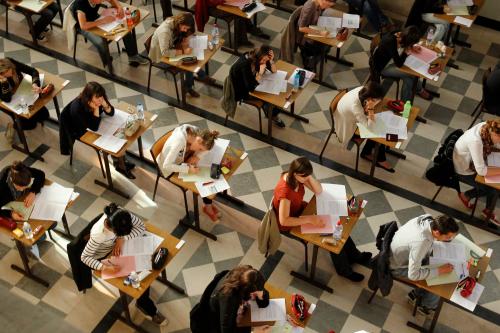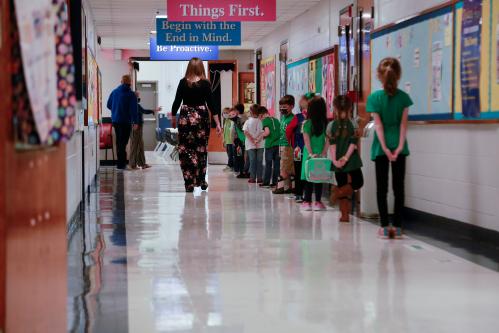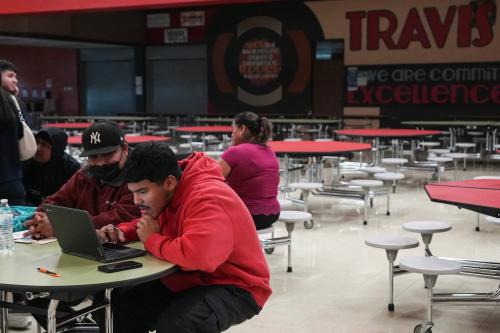This piece originally appeared in The Hechinger Report; the version below has been lightly edited for style.
Education Secretary Miguel Cardona is refusing to back down on a federal requirement that states must administer standardized tests this year, although a letter to state leaders from the Department of Education last month said that states will have flexibility on how to apply results. States concerned about the safety of administering a test during a pandemic may implement shortened versions of assessments.
This relief from the hammer of accountability, if not from the tests themselves, has gotten a mixed reception from anti-testing advocates, school leaders, and teachers who are still trying to ready schools for face-to-face learning. They’re right: Greater accountability and standardized testing won’t give students the technology they need, give teachers the necessary PPE to stay safe, or give families the income to better house and feed themselves during the pandemic so that kids can focus on learning. And if there was ever a time to see how misguided our accountability systems are in relation to addressing root causes of achievement disparities, it’s now.
On its face, relieving students, teachers, and families from the grip of test-based accountability makes sense. We know student achievement, particularly in low-income schools and districts, will dip due to circumstances related to the pandemic and social distancing. We know the source of the decline.
And we currently use standardized tests well beyond what they were designed to do, which is to measure a few areas of academic achievement. Achievement tests were not designed for the purposes of promoting or grading students, evaluating teachers, or evaluating schools. In fact, connecting these social functions to achievement test data corrupts what the tests are measuring. In statistics, this is called Campbell’s Law. When a score has been connected to a teacher’s pay or job status, educators will inevitably be drawn toward teaching to the test, and schools toward hiring to the test and paying to the test, rather than making sure students get the well-rounded education they need and deserve.
However, there is still a role for testing and assessment. We need to know the full extent of the damage from the last 12 months beyond the impact on academics. For one, the federal government should have states take a roll call to see who hasn’t been in school. The government must also assess families’ technological needs if it is to properly support the states financially. In other words, states should be using multiple assessments to address the range of needs of students and their teachers. This is what the focus of academic and non-academic assessment should have always been, not a means to punish the people who are dealing with conditions that erode the quality of an education.
As many have said in different contexts, the pandemic exposed existing structural inequalities that are driving racial disparities. This is as true in education as it is in other sectors. Limited broadband and computer access, home and food insecurity, deferred maintenance on buildings, uneven employment benefits among non-teaching school staff, and fewer resources for schools that serve children of color were throttling academic achievement before the pandemic. They will certainly widen achievement gaps during and after.
As a condition for receiving a waiver, Cardona is requiring states to report on the number of chronically absent students and students’ access to computers and high-speed internet, a request that raised the ire of some Republican lawmakers. Sen. Richard Burr (R-N.C.) and Rep. Virginia Foxx (R-N.C.) objected in a March 25 letter that the requirements for information on chronic absenteeism and access technologies as conditions are “not permitted under ESEA as amended by ESSA.” The letter continued: “They are both outside the scope of what states are seeking to be waived and violate specific prohibitions on the Secretary requiring states to report new data beyond existing reporting requirements.”
Cardona is right in his effort to use tests properly. Gathering information is essential if we really care about closing gaps in educational opportunity and achievement. Information shines light on structural problems. When the effects of structural problems on student learning are ignored, teachers and school boards are blamed for any deficiencies in student performance. Racism ends up pointing a finger at Black education leaders, teachers, and kids for disparities that result from systemic racism.
This is why we should rethink how we use tests in the future.
States have historically found ways to starve majority-Black and -Brown districts of the resources they need to thrive. Let’s be clear: We need to hold racist policies and practices accountable.
Segregation and school financing systems that reinforce segregated housing arrangements reflect the application of racist attitudes about Black people and communities that show up in outcomes. And since No Child Left Behind ushered in an era of accountability in 2001, those accountability systems have largely failed to address those sources of inequality. Black districts in particular have felt as much pain from testing as from the negative conditions that surround schooling. School and district takeovers, mass firings, and the imposition of charter schools have not been applied fairly or evenly because testing didn’t identify the real problems.
Amid a pandemic, testing is a necessary inconvenience to help us understand how we can better address structural racism and other root causes of academic disparities. But if tests aren’t used as a way to support Black districts, students, and families by leading to solutions for structural inequities, then they will only facilitate the epidemic of racism that existed before the pandemic.






Commentary
Standardized tests aren’t the problem, it’s how we use them
March 30, 2021